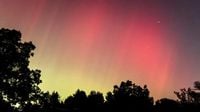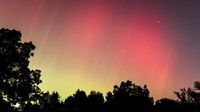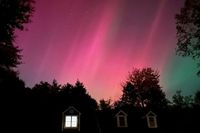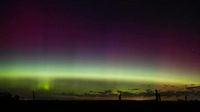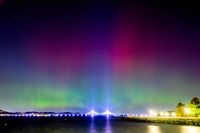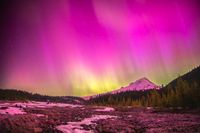Skywatchers across the United States are gearing up for a rare opportunity to witness the stunning display of the northern lights, or aurora borealis, this week. According to the National Oceanic and Atmospheric Administration (NOAA), the phenomenon is expected to be visible on the nights of April 15 and April 16, 2025, thanks to a recent coronal mass ejection from the sun that is likely to disrupt Earth’s magnetic field.
The aurora borealis is a spectacular natural light display that occurs in the polar regions, created by the interaction of solar particles with the Earth’s atmosphere. This week, the aurora may reach further south than usual, allowing residents in several northern states, including parts of Iowa, Vermont, and Oregon, to catch a glimpse.
On Tuesday night, April 15, the aurora is set to be most visible between 10 p.m. and 2 a.m., a timeframe that NOAA advises is ideal for viewing. The agency forecasts a planetary K index rating of 6 out of 9 for that night, indicating a strong likelihood of bright auroral activity. A Kp score in this range suggests that the northern lights could be visible across much of the northern United States.
NOAA’s Space Weather Prediction Center (SWPC) has reported that the Kp index for Wednesday night, April 16, is expected to drop slightly to a score of 5, still indicating potential visibility, particularly in northern regions. The SWPC's forecast indicates that if conditions align favorably, the aurora could be seen in as many as 18 states, including Alaska, Montana, North Dakota, Minnesota, and parts of the Midwest.
For those in Vermont, the forecast is particularly promising. The northern lights could be visible across the state on Tuesday night, and again on Wednesday night, although cloud cover may obscure the view in some areas. According to NOAA, Tuesday evening is expected to be cloudy in Burlington, which could hinder visibility.
Iowans are also in for a treat, with forecasts suggesting that the northern lights could be visible across the northern and central parts of the state on Tuesday evening. By 10 p.m., much of Iowa is expected to have minimal cloud cover, making it an excellent night for viewing. However, the aurora will likely retreat to the northernmost points of the state on Wednesday.
In Oregon, residents in the southeast tip, particularly near Hermiston and Pendleton, may also have the chance to see the lights. The current solar maximum of solar cycle 25 is contributing to the increased visibility of the aurora, which is expected to last into 2026.
To maximize the chances of seeing the northern lights, experts recommend finding a dark location away from city lights, as light pollution can significantly diminish the visibility of the aurora. The best viewing conditions occur during the darkest hours of the night, ideally between 10 p.m. and 2 a.m. If you're hoping to capture the phenomenon on camera, using a wide-angle lens and a long exposure setting can help, as the aurora may be visible on camera even if it isn’t easily seen by the naked eye.
While the northern lights are a breathtaking sight, they are not guaranteed. Factors such as cloud cover and light pollution can obstruct the view, and the SWPC's forecasts are projections based on geomagnetic data. Therefore, skywatchers should keep an eye on the latest updates from NOAA and be prepared to head to a clear, dark location.
As this week progresses, the aurora borealis is expected to remain visible through Wednesday night, with a Kp index forecast of 4 on Thursday, April 17, suggesting that while the activity will decrease, there may still be opportunities to see the lights.
In summary, the northern lights are set to dazzle viewers across many parts of the United States this week, offering a rare chance for those in northern states to witness this natural wonder. With the right conditions, skywatchers could experience the magical hues of the aurora borealis lighting up the night sky, a sight that has captivated humanity for centuries.
